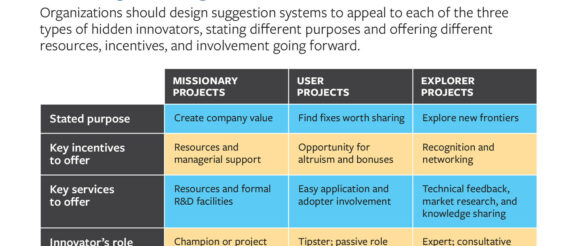New MIT SMR Research Details How Managers Can — and Must — Mine Underground Innovation to Gain Broader Benefit

CAMBRIDGE, Mass., Feb. 21, 2023 /PRNewswire/ — New research released today in MIT Sloan Management Review reveals what drives R&D employees who engage in personal side projects that yield new innovations. These projects are often highly aligned with the organization’s interests, but managers can do more to uncover them and capture their value.
The laptop, masking tape, the first laser printer, and even The Godfather movie can all be traced to underground innovation. If organizations are to take advantage of these projects, they must bring them to the surface.
“It is hard to stop innovators from innovating,” says Jeroen P.J. de Jong, professor at Utrecht University.
“It is hard to stop innovators from innovating,” says Jeroen P.J. de Jong, professor at Utrecht University and coauthor of Mining Underground Innovation. “Underground projects by R&D employees are a valuable source of innovation if the work can be made visible — but are missed opportunities for the organization if they are not.”
De Jong and coauthors Max Mulhuijzen and K. Venkatesh Prasad argue that managers need to better understand what motivates these stealth innovators and what kinds of innovations each is most likely to contribute and should do more to bring their projects to light. They recommend designing and implementing new, more appropriate systems and processes to encourage innovators to bring their work forward. They define three types of under-the-radar projects based on their developers’ motivations:
Missionary Projects are initiated to improve a product or company practice. Their developers have the company’s best interests in mind, but they hold their ideas back until they feel the time is right. Because these projects are eventually communicated and relate closely to company needs, they have better adoption rates than other kinds of underground innovations.
User Projects are developed to solve an individual or work team problem. Innovators find a way to make a task or process easier, more efficient, or more effective. Their focus is more personal, and they are less likely to share ideas unless they hear colleagues complaining about similar problems. These projects tend to address urgent and specific needs.
Explorer Projects emerge from a passion to seek new frontiers. Innovators have a great affinity for and interest in their field of expertise and keep tinkering to break through current technological constraints or to apply their work to bigger societal problems. They are motivated by reputation, meeting like-minded others, and enjoyment of the innovation process. These projects may generate broadly applicable innovations and spring from a more long-term outlook.
Organizations must design suggestion systems to appeal to each of the three types of hidden innovator personalities, offering relevant resources, incentives, and involvement going forward.
“It is important to point out that while innovators are using their own time to create, they are able to offer spillover innovation and can often enhance efficiency on their mainstream projects simultaneously,” notes coauthor, K. Venkatesh Prasad, retired senior technical leader in corporate strategy at Ford Motor Co. “Uncovering underground innovation could have a huge impact for an organization — or society.”
The Research
The research was conducted at Ford Motor Co., which funded the work and assisted with data collection.
The authors initially interviewed 39 R&D employees at two locations in Germany, of whom 27 had recently developed an underground innovation, and four had contributed to others’ projects. They were asked about their motivation, use of resources and collaborators, effort to diffuse their innovations, and observed adoption by others in the organization.
Next, the authors surveyed 929 R&D workers (with a response rate of 25% out of 3,703 employees) in two different countries to validate their findings and to compare underground and formal R&D projects. The survey provided data on 420 underground projects and 479 formal R&D projects.
Finally, they conducted three workshops with managers, members of support staff, and underground innovators to identify how underground innovations can be made visible in a suggestion system.
The MIT Sloan Management Review (MIT SMR) article “Mining Underground Innovation” publishes at 8 a.m. ET on Feb. 21, 2023.
About the Authors
Jeroen P.J. de Jong is a professor at Utrecht University. Max Mulhuijzen is a researcher and doctoral candidate at Utrecht University. K. Venkatesh Prasad is the senior vice president of research & chief innovation officer at the Center for Automotive Research in Michigan; this work was done while he was at Ford. The authors are grateful to Chafica Bounia, Markus Kees and Rocio Luna (Ford), and Brita Schemmann (Hochschule Bremen) for contributing to the data collection.
About MIT Sloan Management Review
MIT Sloan Management Review (MIT SMR) is an independent, research-based magazine and digital platform for business leaders, published at the MIT Sloan School of Management. MIT SMR explores how leadership and management are transforming in a disruptive world. We help thoughtful leaders capture the exciting opportunities — and face down the challenges — created as technological, societal, and environmental forces reshape how organizations operate, compete, and create value.
Connect with MIT Sloan Management Review on:
Media Contact:
Tess Woods
[email protected]
617-942-0336
SOURCE MIT Sloan Management Review
